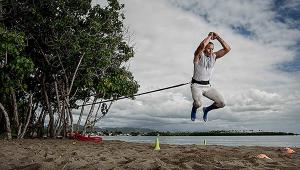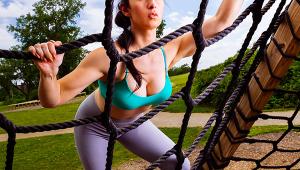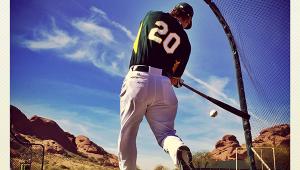Shooting Baseball Sharpens Your Photo Skills

Action, colorful uniforms, human drama and predictable photo opps—baseball and photography go together like hot dogs and beer.
Today I am photographing the New Jersey Jackals versus the Ottawa Champions, two teams in the independent Can-Am League. The game is scheduled for 11:05—an unusually early start to accommodate several groups of youngsters from area summer camps.
Being an independent league means none of the Can-Am teams are affiliated with—or subsidized by—big league teams. The advantage is that throughout the year they weave some sensational teams into their schedule. The international teams that have participated, 20 games each, over the past few years have included the Cuban National Team, who have three Olympic Gold Medals, the Shikoku Island [Japan] League All-Stars and a team from the Dominican Republic—the nation universally regarded as the hotbed for young baseball talent.

The Jackals play their home games at Yogi Berra Stadium, an amazingly clean ball field with seating for 3,784. It’s part of New Jersey’s Montclair State University, and it’s an outstanding family destination only 26 minutes from the George Washington Bridge. Parking is indoors and free, and only about two blocks from the stadium gates.
Today’s weather forecast calls for temperatures near 90 with a 40% chance of thunderstorms. Sky looks clear but I trust NOAA and so should you. I have all of the weather apps on my iPhone but in my experience nothing tops the National Oceanic and Atmospheric Administration.
What to pack? Consider the variables. We’ve got high temperature, chance of rain and a two-block walk. We’re photographing action and color from varying distances, none of which are close. It’s a fun assignment, no rules and no obligations, so we can take anything we own.

Two blocks is not a long walk, but far enough that I don’t want to carry a bag full of lenses. I decide to carry one long zoom—but which and what? My first impulse is to reach for my Fujifilm X-S1, an out-of-production 12-megapixel beauty that features a 26X zoom, equivalent to 624mm. In the past I have shot the Jackals with a Cyber-shot DSC-R1, a vintage 2005 10-megapixel monster with a Carl Zeiss Vario-Sonnar 24-120mm zoom that’s so sharp it will make your eyes bleed.
Either is a good choice on many levels, but I decide that I want to shoot high-speed sequences, so I need my Nikon D800. But which zoom? My Nikon 80-200mm f/2.8 AF-D is a smart option, but I’d like to get a little closer, and I don’t really need the extra speed an f/2.8 provides. I reach instead for my Tamron SP 70-300mm F/4-5.6 Di VC USD. I dislike the fact that the f/stop is not constant, but the lens has very effective image stabilization and is quite sharp.
After mentally skimming over ten dozen alternatives—including packing a compact camera to shoot the crowd—I decide that I should concentrate on one camera, one lens. So it’s the Nikon and the Tamron that make it into the bag.

Since the equipment list is light, I decide to take an equally light bag, the new Think Tank Photo Turnstyle 10. It’s large enough to hold the camera with this lens attached, and there’s enough space for the only other accessory I need: a large, heavy-duty plastic garbage bag in case it rains.
A 40% chance of rain doesn’t sound threatening, but my cameras and I are hydrophobic. My fear of getting equipment wet doubtlessly stems from my long tenure at Minolta Camera, where I saw scads of great equipment reduced to lumps suitable only for doorstops because of someone’s careless disregard for the weather.
Here are the rules I follow when shooting minor league baseball.
Buy the most expensive ticket available, and ask if you can move around between innings if there are empty seats. The most expensive ticket at the Jackals this year is $17, so the entry fee is very reasonable. Changing your position is important if you want to get a variety of shots. The more baseball you shoot, the sooner you’ll settle into a pattern of favorite locations.
Shoot sequences. It’s cool to have a series of images capturing a complete action—like the pitcher winding up and throwing, for example. And you’re much more likely to get a shot you like by capturing several of the same scene.

Practice your timing—it helps you improve overall as a photographer. For example, focus on the batter and try capturing the climax of his swing. To accomplish this, you must follow rule number whichever this is: keep both eyes open. I’m right-eyed so my right orb is stuck in the viewfinder and my left eye is watching the action on the field. Sometimes the squareness of composition goes awry, but I prefer that to using a tripod which invariably slows me down at the ballpark.
Find an exposure combination that gives you action-stopping shutter speeds and moderate depth-of-field. I use f/8, ISO 200 and Aperture Priority almost exclusively when shooting baseball with this Tamron lens. This combination on a bright day gives me a high enough shutter speed to stop a baseball in flight and just enough depth-of-field. I vary the f/stop only when I want to isolate a player on the field, then I shoot at f/4 or the fastest available.
Once there is a runner on first, concentrate on the action that might occur at second base. It takes patience, but there are no replays in live baseball. Be ready to shoot, or sit back and watch the game.
Move around—a lot. The seat I paid for was Section 1, Row 1, Seat 11. It was directly behind home plate and would have been perfect had I been there watching the game only, and not trying to shoot it, because it was separated from the field by a very thick net. Yes, you can shoot through a net—and I did—but I prefer having a clear field of view, thank you.
Who won? The Jackals bested the Champions 8-2 in a rain-shortened game. Isaac Pavlik, pictured at the top of this story, and who is no relation to Dan Havlik, struck out six batters in six innings and notched his 1,000th career Can-Am League strikeout.
Bonus—as if shooting baseball isn’t fun enough, the NJ Jackals offer many promotions throughout the year. The minor league team near you probably does, too. In August, the Jackals promos include fireworks (a photographer’s delight), events for children and even a book signing featuring former Yankee Jim Coates (who had a 13-3 record in 1960 and pitched in three games of the World Series that year).
—Jon Sienkiewicz

















































